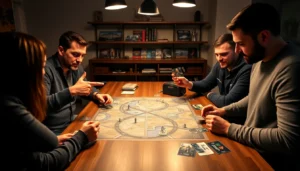Table of Contents
ToggleIn the dimly lit corners of the gaming world, atmospheric horror games lurk like a shadowy figure in a dark alley. These titles don’t just aim to scare; they immerse players in a chilling experience that lingers long after the console is turned off. With heart-pounding soundtracks and haunting visuals, they craft a world where every creak and whisper sends shivers down the spine.
Overview of Atmospheric Horror Games
Atmospheric horror games focus on creating a sense of dread and unease rather than just jump scares. Players immerse themselves in carefully crafted environments that evoke tension. These games rely heavily on audio cues, including eerie soundtracks and unsettling noises, to enhance the experience.
Visual design plays a crucial role as well, with grim landscapes, dark lighting, and compelling art styles drawing players into the narrative. Characters often face existential threats, creating a relatable fear that resonates deeply.
Narrative complexity enriches gameplay, adding depth and making players ponder the storyline long after they finish. Examples of popular atmospheric horror games include “Amnesia: The Dark Descent,” known for its psychological horror elements, and “The Silent Hill” series, recognized for its surreal and oppressive atmosphere.
Mechanics typically involve exploration, puzzle-solving, and stealth, as combat can sometimes feel like a last resort. Crafting a captivating narrative combined with immersive gameplay ensures that atmospheric horror games leave a significant impact on players’ emotions.
Development teams pay close attention to pacing, allowing tension to build gradually. As players navigate these haunting worlds, unexpected twists can heighten the sense of vulnerability. Overall, atmospheric horror games create uniquely intense experiences that resonate with players on a profound level.
Key Elements of Atmospheric Horror
Creating a truly immersive experience in atmospheric horror games requires meticulous attention to various elements. Sound design and visual aesthetics serve as the cornerstones of this genre, crafting a chilling environment that captivates players.
Sound Design
Sound design plays a pivotal role in establishing tension. Eerie soundtracks accompany unsettling noises, heightening anxiety and fear. Subtle auditory cues, such as whispers or creaking floors, evoke a sense of being watched. Background sounds contribute to the overall atmosphere, emphasizing isolation and dread. These elements enhance storytelling, compelling players to engage on a deeper level. A well-crafted soundscape resonates emotionally, leaving lasting impressions even after gameplay ends.
Visual Aesthetics
Visual aesthetics define the game’s mood and impact. Grim landscapes often feature dark lighting, creating an oppressive atmosphere. Environment details, like decaying structures or fog-laden paths, heighten immersion. Artistic choices influence player perception, as haunting imagery elicits fear and curiosity. Characters and settings contribute to overall narrative coherence, enhancing emotional responses. Well-executed visuals invite players to explore, deepening their connection to the storyline.
Notable Atmospheric Horror Games
Atmospheric horror games leave lasting impressions through immersive storytelling and chilling environments. Here are three notable titles that exemplify this genre.
Game 1: Amnesia: The Dark Descent
Amnesia: The Dark Descent revolutionized the horror genre with its intense psychological elements. The protagonist, Daniel, explores a dark, foreboding castle filled with terrifying creatures. Players must manage resources, solving puzzles while avoiding direct confrontation. Eerie sound effects and a haunting soundtrack heighten tension. The game cleverly uses light and shadow, enhancing the sense of dread as players navigate through oppressive environments, immersing them in a fearful atmosphere.
Game 2: Silent Hill 2
Silent Hill 2 stands as a classic in atmospheric horror. This title delves into psychological horror as players assume the role of James Sunderland, searching for his deceased wife. Symbolism and surreal environments craft a disturbing narrative where monsters embody personal fears. The fog-shrouded streets of Silent Hill amplify feelings of isolation. A chilling soundtrack accentuates the emotional impact, making players question reality and confront inner demons throughout the journey, ultimately providing an unforgettable experience.
Game 3: Layers of Fear
Layers of Fear offers a unique take on psychological horror through the perspective of a disturbed painter. The game unfolds in a constantly shifting mansion that mirrors the protagonist’s deteriorating mind. Players explore beautifully crafted yet unsettling visuals that reflect themes of madness and obsession. The sound design creates a chilling experience, with haunting whispers and disorienting audio cues. Each new room presents psychological puzzles that unravel the narrative, inviting deeper exploration into the painter’s tragic story and emotional struggles.
The Impact of Atmosphere on Player Experience
Atmosphere significantly shapes player experience in atmospheric horror games. An engaging environment elicits genuine emotions, boosting player involvement and immersion. Sound design plays a pivotal role in crafting this atmosphere, employing eerie soundtracks and subtle audio cues that amplify feelings of dread. Players often feel tension build as every creak and whisper hints at lurking dangers.
Visual aesthetics also define the emotional landscape of these games. Dark lighting creates a sense of foreboding, while decaying structures add realism to the environment. Grim landscapes invite exploration, warding off the feeling of safety and drawing players deeper into the narrative. Such meticulous attention to detail ensures that fear remains palpable throughout the gameplay.
Character experiences enhance the atmosphere further. Facing existential threats allows players to connect deeply with the protagonist’s journey, amplifying their fears and sympathies. The way narrative unfolds often keeps players questioning their understanding of reality, fostering an atmosphere rich with psychological tension.
Gameplay mechanics reinforce this unnerving atmosphere. Exploration encourages players to uncover secrets, while puzzle-solving adds intellectual engagement. Stealth mechanics encourage cautious movement, which heightens anxiety and contributes to a more intense experience. Combat options typically remain limited, prompting players to rely on their wits to survive.
Noteworthy titles exemplify the atmosphere’s impact. “Amnesia: The Dark Descent” immerses players in psychological terror through fear-inducing resource management. “Silent Hill 2” creates an unsettling narrative, where the town’s fog envelops both the protagonist and players in deeper fears. In “Layers of Fear,” the shifting mansion mirrors the protagonist’s mind, layering haunting auditory design over the backdrop of mental collapse. Each of these examples showcases how atmosphere profoundly influences player engagement and experience in atmospheric horror games.
Atmospheric horror games offer a unique blend of storytelling and immersive experiences that linger long after the credits roll. By focusing on sound design and visual aesthetics they create a palpable sense of dread that pulls players into their chilling worlds. The careful pacing and gameplay mechanics enhance this tension making each moment feel significant. As players navigate these haunting landscapes they confront not just external threats but also their own fears and anxieties. With titles like “Amnesia: The Dark Descent” and “Silent Hill 2” leading the charge the genre continues to evolve while captivating audiences seeking a deeper emotional connection to horror.




